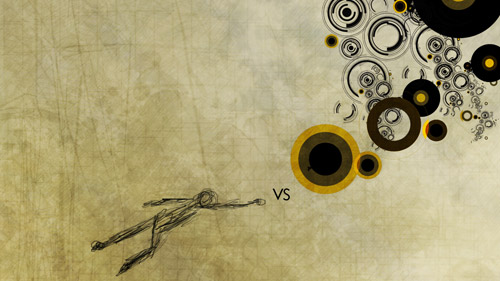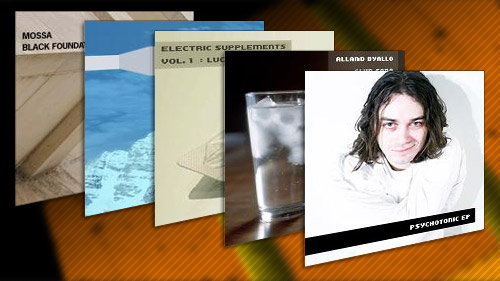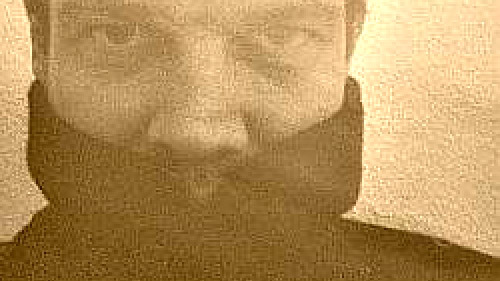
Don't Take Drugs, Take Camomille!
The Love For Music // Camomille is one of the oldest and most exceptional netlabels to date. With Vince Fugère as its head Camomille set some high fidelity milesstones in the netaudio world. The sound could be best described as a mixture of Ambient, Indietronica and IDM. With extraordinary strong illustrations and artworks Camomille confronts its audience with beautiful art. In our interview Vince unveils the origin, secrets and history of Camomille.
Interview done by Dave Keifer who does odd jobs for Dog Eared Records and releases music as Cagey House.</div>
The Roots and Origin Of Camomille Netlabel
Phlow: Can you describe the early Bulletin Board days? For instance: Was it a big scene? How did people find out about it? How did you get involved? Were the participants mostly musicians - or did non-musicians use it to find music as well? How did it actually work?
<img class="left" src="https://phlow-magazine.com/images/vince-fugere-camomille-netl.jpg"
Vince: I started being in contact with the BBS (Bulletin Board System) scene back in 1994-1995. Back then an internet connection was pretty much out of the question and it only started getting some media attention.
It all started for me when a friend of mine invited me to connect to another friend's computer using my really high-speed 14.4 dialup modem to play games on his computer. He had created an interface where we could browse his "site." It was all done in ANSI/ASCII interfaces and there was a spot to download music and images, and also a forum to chat. Only 2 users could be on it at any time. It is back then that I got my first contact with my passions for graphic design and music.
There was an art-form unfamiliar to most now which is ANSI art. Back then, the DOS interface we used to connect to BBSs was 16 colors, if I remember correctly. Some early graphic artists used this extremely limited set of colors to create absolutely beautiful renderings. From that first BBS you connect then you can see the other BBSs in your area code in the links section.
I started researching this intriguing ANSI art and found that some artists had created groups from which they published Artpacks. One very popular group back in the day was ICE. What was great is that in order that your local BBS have these files and artpacks and updates from these Artgroups, they had to connect to other BBSs way outside your area code, and the distribution of new files was made this way. Hence the feeling of an underground community we all felt while connecting to BBSs.
/images/camomille-portrait-1.jpg"
Design & Artwork taken from comic book by Selfmademusic
On those artpacks, you could find ANSI art, poetry and weird files that had weird extensions, like .mod, .s3m, .xm and .it. After some research I found "players" for those kind of files and to my amazement they were music modules. A module, basically, is a file that is somewhat like a .midi file or a sequence file from your favorite sequencer, but that can play only .wav samples that are imbedded in the file itself. There were different reasons for this. From what I know, the tracker (music software) in various forms, was used to create the music found in Amiga and nintendo or any early game system because the filesize was so small. For early nintendo games, well most games anyways, you only had to store 4 really small wav files (a sine wave, a square wav and 2 noise samples for example) and use them in different ways to create sound. Hence the chipmusic scene that is still pretty huge and still getting bigger to this day. This small file size was perfect for the BBS, with out 14.4, it was hell to download .mp3s.</div>
/images/camomille-portrait-2.jpg"
Design & Artwork by Adnan-Alin Vasile & Felix Petrescu
Vince: I remember downloading my first mp3, an Eric Clapton track, and it took me 4 hours to download it with its impressive 4.5 mo, while a chiptune most of the time only weighs about 64 kilobyte. I fell in love with this filetype and started looking around for it on local BBSs. I remember groups like Martyr, N.o.i.s.e., Five Musicians and more. Then I got Impulse Tracker, a newer generation of tracker in which you could pull more tricks and have a wider reach musically and technically, and I started to do some modules.
All this was called "the demoscene" back then, for a simple reason. These artgroups used to create (and still do) what we call Demos, which is basically a music video, all done in hard coding and using module music as its soundtrack. You can still find some great Demos on www.scene.org.
There is another whole history of demos and demogroups, but from what I gather is they started with Cracktros, which is a little video the early crackers of programs used to put in there cracked software .zips. Then the internet came and the module world took the step to the internet. And that's when the netlabel scene was born. But they weren't aware yet, what they created.
/images/camomille-portrait-6.jpg"
Design & Artwork by 143
The first center that was created for the BBS-turn internet module groups was scene.org, that hosted a selected number of modules. At that time filesize was still very important, so all you could download from the sites were next-generation module files like .it and .xm. I remember going everyday to sites like n.o.i.s.e. music, KFMF, monotonik, tokyo dawn records, total eclipse, five musicians, and in time, hellven, fromage, rebound, mephtik, tpolm. As the years went by, trackers weren't doing chip anymore, but using complex time signatures, higher quality samples and exploring different styles, which in my mind, I have the arrogance to say created IDM. But that's a different story *smile*.
The community grew larger everyday, thanks to scene.org, nectarine radio (a radio that played modules live), mirc and traxinspace.com. For a long a ring of tracker groups that released free modules. I can't say who exactly started posting .mp3 music, but if I recall, it would be between miasmah, mono and nashmeja. As we all got better connections, the module started to die out and hence, when the group owners stop calling their organisations music groups or tracker groups, the name netlabel surfaced.
There are many reasons why .mp3 took over, but to put it simply: the musicians wanted to record real synthesizers, vocals, live guitars, etc. and the module started to weigh more in module format than mp3 and new programs and sequencers showed up, namely Buzztracker, cubase, reason and logic.
I started Camomille in 2001, at the end of the module buzz and decided to go full swing on .mp3 probably around release number 13.
/images/camomille-portrait-5.jpg"
Phlow: Obviously the current netlabel-scene enjoys a lot of technical advantages over the BBS scene. It also seems that there is a more more developed structure. And, indeed, a lot of folks are looking at ways of developing that structure further. There's Mike Gregoire's article "An infrastructure for take-over", for instance, in which he proposes some ways of increasing the netlabel scene's popularity among music listeners. But as someone who both participated in the BBS scene and runs a netlabel, do you feel that anything has been lost as things have become more codified? Are there positive aspects of the BBS scene that you think have failed to translate to the netlabel scene of today?
Vince: I love that free music is getting more and more popular and more and more sought after, don't get me wrong, but the state of the current netlabel scene sure does have a lot to envy to the early tracker days. I mean I remember chatting with friends and the scene actually had legends and heroes, like xerxes, purple motion, necros, etc. There was a real following and every time someone released something it was a really exciting time. Now the scene is flooded with netlabels and releases, it's so hard to keep up that people don't have that passion anymore. I mean sure it's still exciting when one of the big netlabels release something. But but good music gets lost in the myriad of releases you see each day.
And I'm pretty sure there's great music in there too. We need a central, other than archive.org - which is amazing but its just a hosting platform, not a place where you can easily find good quality music, we need reviews and articles like you guys are doing. A place where everyone from the netlabel world can meet and chat. Sure there are a good couple of newsblogs but again it's hard to keep up with them. I rarely get excited anymore to anything that's being released, just for the simple fact that I don't know where to look anymore, there's just too much.</div>
/images/camomille-portrait-4.jpg"
Design & Artwork by 143
Phlow: How did you come to start camomille? And where do you think camomille fits in with the current scene?
Vince: Well, the idea made its way back in the end of 2001. I was in a deep depression and after taking drugs which made me feel nothing; my doctor suggested I could maybe drink Camomille tea. And I started doing so. So late at night I was having panic attacks and I started drinking camomille tea listening to Chimera's "A long way from heaven" (released on Hellven) and I can say that Camomille tea and Chimera's emotional ambient music actually saved my life. So realizing the importance of music, the importance of ambient music and the importance of free music, I decided to start camomille music, a place where, originally, you could find deep, emotional ambient music.
Camomille at the beginning, was a newbie netlabel but as time passed I got more and more people on it with some recognition, especially from the older tracker scene like xerxes, mv and later mikael fyrek, makunouchi bento, grandma etc.
So I'm starting to think that at number 100, Camomille has made its dent into the scene and it's a testament that Camomilles there to stay. We offer an honest ecclecticism, that I think our fanbase appreciates. Personally, looking back and looking at it now, I couldn't be happier, and I feel more like someone who operates a machine in the sense that camomille kind of became its own entity.</div>
Phlow: It must be really rewarding to see camomille have come so far. What's the 100th release going to be?
Vince: We've just released camomille 100 and I must say it's been a lot of hard work and I'm very, very proud of what it is. Lackluster, Twerk, Proswell, Khonnor, Ilkae, Julien Neto, Hunz, ST, Anders Ilar are just a few of the names on there and they're all people I deeply respect and of who I'm a big fan. And that goes for everyone on the compilation. And for the first time we've added the graphic design side to it, showcasing 13 different artists with their takes on "Cycles."</div>
Phlow: Finally, what advice would you give to someone who's just starting a net-label?
Vince: As far as advice, I'd say, do it for fun, and be sure to release something that you love, not that you like, not that you feel is mediocre, but the artist carries some weight on whatever's left of this scene. Passion always brings good things and if you always stay pertinent you'll eventually get a following of fans just as dedicated to the music you release as you are.</div>
Phlow: Thank you very much for the interview!
Netlabel Links
Netlabel: http://camomille.genshimedia.com



